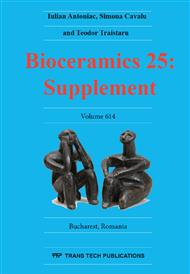[1]
J.R. Kelly, Ceramics in restorative and prosthetic dentistry, Annu Rev Mater Sci 1997; 27: 443-468.
DOI: 10.1146/annurev.matsci.27.1.443
Google Scholar
[2]
A. H De Aza., J. Chevalier, G. Fantozzi, M. Schehl, R. Torrecillas, Crack growth resistance of alumina, zirconia and zirconia toughened alumina ceramics for joint prostheses, Biomaterials 2002; 23: 937-945.
DOI: 10.1016/s0142-9612(01)00206-x
Google Scholar
[3]
S.I. Voicu, A.C. Nechifor, B. Serban, G. Nechifor, M. Miculescu, Formylated polysulfone membranes for cell immobilization, J Optoelectron Adv Mater 2007; 9: 3423-3426.
Google Scholar
[4]
McLean, John, The Science and Art of Dental Ceramics, Quintessence Publ. Co., Chicago, vol I, (1979).
Google Scholar
[5]
G. Nechifor, S.I. Voicu, A.C. Nechifor, S. Garea, Nanostructured hybrid membrane polysulfone-carbon nanotubes for hemodialysis, Desalination 2009; 241: 342-348.
DOI: 10.1016/j.desal.2007.11.089
Google Scholar
[6]
B.R. Lawn, A. Pajares, Y. Zhang, Y. Deng, M. Polack, I.K. Lloyd, E.D. Rekow, V.P. Thompson, Materials design in the performance of all-ceramic crowns, Biomaterials 2004; 25: 2885-2892.
DOI: 10.1016/j.biomaterials.2003.09.050
Google Scholar
[7]
G.E. Stan, D.A. Marcov, A.C. Popa, M.A. Husanu, Polymer-like and diamond-like carbon coatings prepared by RF-PECVD for biomedical applications, Dig J Nanomater Biostruct 2010; 5: 705-718.
Google Scholar
[8]
X. Wang, D. Fan, M.V. Swain, K. Zhao, A systematic review of all-ceramic crowns: clinical fracture rates in relation to restored tooth type, Swed Dent J Suppl 2011; 213: 9-84.
Google Scholar
[9]
G.E. Stan, I. Pasuk, M.A. Husanu, I. Enculescu, S. Pina, A.F. Lemos, D.U. Tulyaganov, K. El Mabrouk, J.M.F. Ferreira, J. Mater. Sci. - Mater. Med. 2011; 22: 2693.
DOI: 10.1007/s10856-011-4441-1
Google Scholar
[10]
J. Chevalier, A.H. De Aza, G. Fantozzi, M. Schehl, R. Torrecillas, Extending the lifetime of orthopaedic implants, Advanced Mater 2000; 12(21): 1619-1621.
DOI: 10.1002/1521-4095(200011)12:21<1619::aid-adma1619>3.0.co;2-o
Google Scholar
[11]
S.I. Voicu, A. Dobrica, S. Sava, A. Ivan, L. Naftanaila, Cationic surfactants-controlled geometry and dimensions of polymeric membrane pores, J Optoelectron Adv Mater, 2012; 14(11-12): 923-928.
Google Scholar
[12]
B. Al-Amleh, K. Lyons, M. Swain, Clinical trials in zirconia: a systematic review, J Oral Rehabil 2010; 37(8): 641-52.
DOI: 10.1111/j.1365-2842.2010.02094.x
Google Scholar
[13]
G.E. Stan, C.O. Morosanu, D.A. Marcov, I. Pasuk, F. Miculescu, G. Reumont, Effect of annealing upon the structure and adhesion properties of sputtered bio-glass/titanium coatings, Appl Surf Sci 2009; 255: 9132-9138.
DOI: 10.1016/j.apsusc.2009.08.083
Google Scholar
[14]
N. Claussen, Fracture toughness of Al2O3 with an unstabilized ZrO2 dispersed phase, J Am Ceram Soc 1976; 59(1–2): 49-51.
Google Scholar


